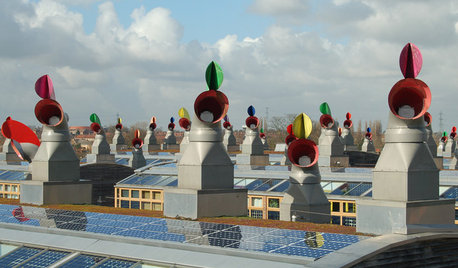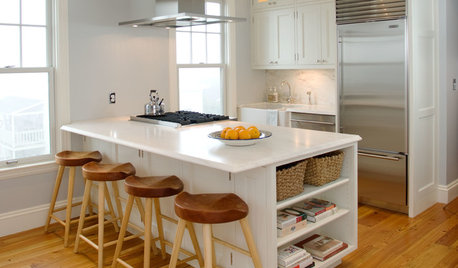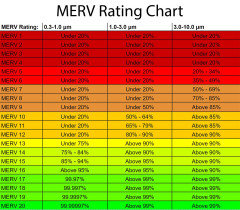Odor from Air Conditioning Ducts
kelli_ga
2 years ago
last modified: 2 years ago
Featured Answer
Comments (34)
kelli_ga
2 years agoRelated Discussions
Unpleasant odor from gas furnace return air intake
Comments (2)Thanks, bpChill -- you are correct, and it was good to have the furnace examined and cleaned up (the duct cleaning workers removed and cleaned the large fan box). However, the odor problem remained -- until I decided to spend most of the next day crawling around down there and checking everything out a lot closer. With the furnace running, I noticed that a large section of old fiberglass insulation was billowing out with hot air blowing from behind it. Upon close examination, I discovered that the original installers had left a 5" x 8" gap in the sheet metal case that comprises the blower box, and had apparently tried to cover it with foil-covered tape that had long since torn away. This was why the crawl space was always so warm when the furnace operated -- I was losing hot air into it!!!! I fastened down the sheet metal with screws, bought a small piece of sheet metal and screwed it down over the gap, installed new foil-covered (code) duct tape over all the gaps and wrapped the top of the furnace with a new bat of foil-covered fiberglass insulation. It was while doing this that I pushed up the wide, flexible ducting from the main house air intake where it entered the bottom of the furnace -- and saw a rat tail protruding from the narrow gap between the bottom of the sheet metal air intake box and the concrete pad on which the whole heater sat. The dead rat attached to the tail had apparently crawled in there, got stuck and died, perhaps a week ago. And jeez, did it stink!! Now the source of the odor was found; I disposed of the rat and scraped and vacuumed away the adherent material from it on the concrete, vacuumed up the remaining rat droppings on and around the pad and the old insulation, and pulled out and and disposed of the old, torn insulation. Within a few hours, the odor from the air intakes inside the house was gone. Success! The moral of the story is, if you smell what seems like a dead animal, it certainly IS a dead animal. One thing, though that concerns me about the furnace -- I've read that the electronic igniters (carbide or nitride)on these furnaces are supposed to last maybe 5 years. Mine is still going strong after 15!...See MoreQuote for Heating and Air Conditioning-Good deal?
Comments (11)Baldloonie- I think it's just to run ducts out to back room which is only electric heat. The room is right off the room with the furnace. Ryanhughes- The 10,000 rebate is part of the NJ Clean Energy Program. It's a rebate a lot of people aren't familiar with but it's great. It's actually a reimbursement for saving energy for buying new higher energy efficiency products. You can be reimbursed for 50% of the cost of the work up to $10,000 plus have an opportunity to finance the balance at a 0% interest rate for up to 10 years if you reach certain efficiency requirements. There's specifics such as you obviously must meet certain efficiency levels, can only use contractors certified in this program, must have an energy audit done, etc. Check these 2 sites out: Explains the efficiency requirements for loan (This site also shows programs for some other states but I know nothing about those) www.energyfinancesolutions.com Explains the steps to get the maximum rebate of 10,000 http://www.njcleanenergy.com/residential/programs/home-performance-energy-star/benefits-and-incentives...See Morereplacement of heating & air conditioning units
Comments (1)Quote #1 does not include increasing the size of the ductwork which needs to be done because you are replacing a 2 ton with a 3 or 4 ton (depending on the quote) and a 1.5 ton with a 3 or 3.5 ton. Quote #2 also includes zoning equipment/controls. There is a VERY large discrepancy in size of existing units vs. proposed units(both quotes) Did any of these contractors do a heat loss calculation? You should ask to see a manual J, which will determine the proper size system for the home. I understand the size needs to be increased due to the additions to the home, but what is the proper size? I would not sign any contract without a heat loss calculation first. That is the basics. Post back and we can continue this. Or email me @ woody22478@yahoo.com. I can forward you info and links to help explain better....See MorePee-ew, My Air Conditioning System Stinks (literally)
Comments (9)If you turn off the first floor AC, does the lilac smell migrate to the first floor from your cellar table? If not, you are right and the installer is wrong. You have a duct leak somewhere that is drawing cellar air into your system. That depressurizes the cellar and pressurizes the first floor. Outside air is then sucked into the cellar and inside air blown out of the first floor area. That seems like way too much air leakage for a new system. It is inefficient at best, but it can cause other problems as well. Depressurizing an area of the home can be dangerous. It can prevent the exit of combustion fumes from water heaters, boilers and furnaces and fill the house with them. What kind of heat and water heater do you have and where are they located? If you cellar is cool and outside is humid, drawing in outside air could lead to higher humidity in the cellar if the dew point of the outside air is lower than cellar temperature. f the system is not supposed to condition the cellar, you should not see much of an effect on humidity down there. What was the cellar humidity like before AC install? You might have to attack this problem separately. Is it warm or cool down there? Did the same outfit install the second system?...See Morekelli_ga
2 years agoCharles Ross Homes
2 years agoAustin Air Companie
2 years agoCharles Ross Homes
2 years agoAustin Air Companie
2 years ago
Related Stories

GREEN BUILDINGLife Without Air Conditioning? These Passively Cooled Homes Say Yes
Ever wish you could chuck that money-sucking air conditioner? Check out these homes that keep the air cool and flowing passively
Full Story
LIFE6 Ways to Cool Off Without Air Conditioning
These methods can reduce temperatures in the home and save on energy bills
Full Story
DECORATING GUIDES12 Ways to Cool Your Home Without Air Conditioning
If your summer energy bill is leaving you hot under the collar, consider these savvy alternate strategies for cooling down
Full Story
DECORATING GUIDES10 Ways to Hide That Air Conditioner
Feeling boxed in designing around your mini-split air conditioner? Try one of these clever disguises and distractions
Full Story
MOST POPULAR5 Ways to Hide That Big Air Conditioner in Your Yard
Don’t sweat that boxy A/C unit. Here’s how to place it out of sight and out of mind
Full Story
HEALTHY HOMEGet Cleaner Indoor Air Without Opening a Window
Mechanical ventilation can actually be better for your home than the natural kind. Find out the whys and hows here
Full Story
KITCHEN DESIGN16 Practical Ideas to Borrow From Professional Kitchens
Restaurant kitchens are designed to function efficiently and safely. Why not adopt some of their tricks in your own home?
Full Story
HEALTHY HOMEA Guide to Indoor Air Purifiers
Get the lowdown on air filtration systems for your house and the important ratings to look out for
Full Story
KITCHEN DESIGN20 Kitchen Must-Haves From Houzz Readers
We asked you to tell us your top kitchen amenities. See what popular kitchen features made the list
Full Story
DECORATING GUIDES10 Design Tips Learned From the Worst Advice Ever
If these Houzzers’ tales don’t bolster the courage of your design convictions, nothing will
Full Story





klem1